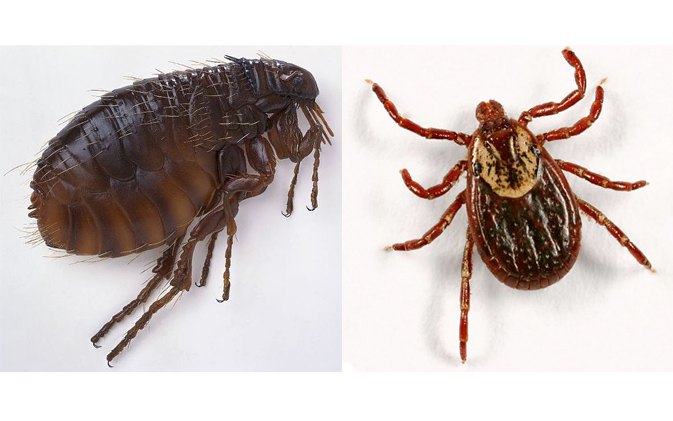What’s The Difference Between Fleas and Ticks?

Know the enemy – we’ve got intel on what makes fleas and ticks tick.
Spring is here… and that also means that fleas and ticks are making their way to your dog. They think of your dog as their summer home and they plan to take up residence for generations unless you evict them. And it’s not just that these parasites are pesky and nasty. There is also a risk of your pet contracting various diseases and developing certain health issues because of the bloodsucking tenants in his coat. That’s why it’s important to prevent an infestation with fleas and ticks and if one occurs- to react on time and eliminate the parasite once and for all. But before you get to action, it’s important to know what exactly you are dealing with- because fleas and ticks might both be little pains in the butt, but there are many differences between the two.
Even though both fleas and ticks are parasites that feed on your pet’s blood, that’s where their similarities end. If you are hoping to eliminate either fleas or ticks (or if your pooch is unlucky- both), you have to know thy enemy. So read on and get all the information you need to rid your pet of these tedious bloodsuckers.
This is a sponsored placement
Dealing with fleas and ticks means all hands-on deck – you’ll have to be patient, persistent, and use the right products if you want these nasty bloodsuckers away from your pet and you for good. If you notice fleas on your pet or a tick attached to their skin, you will have to treat them directly to eliminate the existing parasites, but also areas where they spend time – such as their bed, the sofa, or even your backyard – to fully eradicate fleas and ticks in all life stages. Advantage provides solutions for all the steps in the process, with options tweaked for everyone’s needs and preferences. If you want an easy to apply, waterproof flea and tick treatment for your pet, there’s K9 Advantix II, and if you want a fast-acting but temporary help with your battle against parasites, you can pick up Advantage® Flea & Tick Dog Treatment Spray or Advantage® Flea & Tick Dog & Puppy Shampoo. For those that prefer more long-lasting protection that doesn’t have to be applied in a special way, a Seresto® Flea & Tick Dog Collar is the way to go. But don’t forget to treat the premises, either! For complete protection of your home, go for Advantage® Flea & Tick Household Spot & Crevice Spray, Advantage® Household Fogger, or Advantage® Carpet & Upholstery Spray, depending on the severity of the infestation. And once that’s done, be sure to eliminate the parasite threat lurking in your backyard with the Advantage® Yard & Premise Spray which can be attached to the hose for a fast and easy application.
Save up to 10% off Flea & Tick Products at PetSmart.com Valid 4/4 - 6/5
Fleas
Even though this insect is wingless, it can jump like any NBA player. From another dog to yours, from your dog to your carpet, from the carpet to your cat… When a meal presents itself, fleas have no problem finding a way to attach themselves. In fact, they won’t mind feeding off of you, either- in cases where infestations with fleas spread all over the home, these bloodsuckers are known to jump and bite the unsuspecting pawrent’s legs.
Despite their busy jumping schedules, fleas can be tough to spot – they measure in at 1/16 to 1/8-inches long. And that’s just the adult, well-fed (not to say chonky) fleas we’re talking about, not young specimens. But just because you don’t always see them, it doesn’t mean they are not there. With a lifespan of about 100 days, fleas like to settle in and stay on one dog. That means once it jumps on your dog, the flea will stay there until it dies. And why would it go anywhere else? Your dog has everything it needs to live comfortably – it feeds off your dog (yum!) and starts having babies as it finishes eating. Yes, when fleas make a home out of your pet’s fur, they make it a multigenerational one. For several weeks, they will lay about 20 to 40 eggs a day. And these eggs will go wherever the dog goes, so shedded hair that contains eggs can land anywhere. And we mean ANYWHERE. Fleas can infest carpets, hardwood floors, your furniture, etc- which is why it’s important to treat both the flea-infested pet and their environment when dealing with fleas.
Happier in a mild climate, fleas prefer heat to cold, so they would rather spend their time indoors where it’s toasty warm. So your pet’s coat kind of makes the perfect habitat: there’s an all-you-can-eat buffet, the temperature is just right, and hey, the pooch lives indoors so no worries about the cold or the elements ruining their fun. To make matters worse, fleas don’t come to their new home without a housewarming present. These annoying creatures can carry bartonellosis and tapeworm to pass along to your dog. Like the fact that their constant biting causes incessant scratching and allergies wasn’t enough on its own!
Ticks
A close cousin to spiders, the tick is considered to be an arachnid (thanks to their eight legs). Unfortunately, when one bites, you don’t get to be a superhero. Ticks are bigger than the flea, measuring in at ¼ to 1/8-inches long. While they are not blessed with the same super-jumping abilities like fleas are, ticks also have no problem attaching themselves to a suitable host. For worse or for the better, they don’t mind moving from animal to animal – they aren’t too picky where they set up house. In fact, ticks can be found on snakes, lizards, and humans. Their life cycle can last anywhere from three weeks to three years. You wouldn’t think that these little bloodsuckers would be picky, but they are. They will wait until they find the right home, and then leave to find another host to sponge off of. They just can’t spend too long on one dog. Even so, ticks can cause problems even if they feed for minutes- they don’t need long to wreak havoc on your pet’s immune system. As larvae, nymphs and adults, they will go from host to host through each life stage.
And let’s talk about eggs. After feeding off the dog, the female tick will fall from its host and lay thousands of eggs at one time (yikes!). Once it has finished with this task, the tick will die, leaving behind a new generation to carry on its dirty work. Happiest in cold temperatures, the tick doesn’t mind the winter climates. As for diseases, the tick carries around plenty of potentially deadly diseases, including Lyme disease and Rocky Mountain spotted fever.
Not all ticks are the same, though, and there are hundreds of unique tick species in the world. As for those that like to feed on dogs, the most common species include deer ticks (also known as black-legged ticks), Lone Star ticks, American Dog ticks, Brown Dog ticks, Rocky Mountain Wood ticks, etc. There are differences in both the appearance of the ticks and the damage they can make when they bite- it’s important to know what types of ticks are common in your area so you can be prepared for the right prevention and treatment.
Treat Your Pet All Year Long to Protect Against Ticks and Fleas
Fleas and ticks aren’t just gross, they also carry a variety of harmful diseases that can take their toll on your pet—as well as on your health if you are ever bitten! So the best thing that you can do is protect your pet by taking preventative steps all year long.
First off, there are a lot of flea and tick products specifically designed for use on cats and dogs, and you can talk to your veterinarian about which product would be the safest and most effective for your unique companion. Then, apply the product according to its dosing schedule so that your pet is consistently protected against these external parasites. Note: only use cat products on cats, and only use dog products on dogs (never use a dog product on a cat, and vice versa). Be sure to stick with the highest quality, most trusted flea and tick products in order to avoid dangerous side effects. Again, speaking with your vet can give you the guidance that you need to pick the product that’s right for your furry friend.
Also, keep in mind that tick bites and flea bites can cause symptoms of illness. So if your pet starts experiencing any new symptoms, such as hair loss, skin inflammation, itching, fatigue, weakness, pale gums, fever, swollen joints, poor appetite, lameness, painful muscles or joints, bleeding problems, depression, or signs of a tapeworm infection, be sure to consult with your vet right away. And if you take your pet to the vet for regular checkups, you can also ask him or her to examine your pet for any signs that fleas or ticks are a problem.
In addition to using medications that have been proven to repel and kill ticks and fleas, you can also take other steps to prevent infestations and bites. For example, whenever you go into the great outdoors, take a few minutes to check yourself and your pet for any bugs that might’ve crawled onto you. This is especially important when you are hoping to prevent ticks from taking hold and potentially spreading disease to you or your companion. Remove any ticks that you find crawling around, and if you notice that one has bitten your dog or cat, it’s a great idea to see your vet for a checkup. If you’re ever bitten, consult with your doctor too.
Keeping your own yard free of pests is also wise. You can use pesticides in your yard, or you can take precautions like keeping your lawn short, removing debris like leaf litter, and maintaining a clean outdoor space that will be less likely to provide a good home to fleas and ticks.
Finally, grooming your pet on a regular basis isn’t just a good way to keep her coat looking lovely, it’s also a smart way to check for parasites that might be making their home in your animal's fur. Plus, when you groom your companion, it’s a great opportunity to bond with your dog or cat and show her how much you care.
Natural Ways To Combat Fleas And Ticks
Pet parents who take a natural approach to flea and tick prevention swear by food-grade diatomaceous earth. You can use it just about anywhere your dog will be, and it will literally cut holes in the body of fleas who try to mess around with your dog. Yes, sort of like ninja dirt. It’s super-absorbent as well and will cause fleas to die simply due to dehydration. Diatomaceous earth (DE) can also be used as a repellant in your home as well. Use it around baseboards, dog beds, windows, or carpets, and then vacuum several hours later to get rid of the fleas you’ve killed. You can continue to do that until they’re gone, and it’s safe around your pets, though you want to be sure your dog doesn’t try to inhale or eat it.
Some pet parents also use a combination of water, vinegar, and soap to keep fleas and ticks away. You can combine a quart of water, a cup of white vinegar or apple cider vinegar, and a cup of dish soap or baby shampoo to have a flea and tick bath to use on your dog once or twice a month. Vinegar and fleas/ticks don’t mix and this can prevent infestations from happening.
The same can be said for lemon wash–lemon juice is another natural preventative. It takes a bit more work because you’ll need to apply it each day, but if you put it in a spray bottle, not a big deal to do. Take 4 to 6 slices of fresh lemon, a tablespoon of salt, and six cups of water. Boil the water and then add the salt and lemon. Let it boil for two minutes and then steep for 24 hours. Apply after your dog is bathed, and then daily to keep the fleas and ticks away.
What to Do if You Spot Fleas or Ticks
So, you’ve spotted fleas moving within your pet’s fur or a tick patched onto your dog’s neck, you may be left wondering what to do next. The good news is that identifying that the problem exists is the first step toward getting rid of your unwanted visitors.
How to Remove a Tick
If it’s a tick that you’ve located, removing it from your pet is your first priority. The longer that the tick remains embedded in your pet, the higher the risk of illnesses like Lyme disease. Take a fine-tipped set of tweezers, carefully take hold of the tick as close to the surface of the skin as possible and pull the tick straight up with even pressure. Don’t twist the tick or pull it sideways. This could cause the mouth of the tick to break off and remain stuck.
Another option for the removal of a tick, one that’s even easier than using tweezers, is to use a tool called a tick key. These tools have a tear-drop hole on one end. To remove the tick, place the larger end of the hole over the tick. Slowly pull the key until the tick is stuck in the smaller end of the hole. Continue to pull in that direction, not lifting the tick. It is designed to remove the full tick quickly and easily with no additional effort on your part.
After you have removed the tick, place it in a sealed bag or container. Clean the area of the bite with soap and water or rubbing alcohol. You can bring it to the public health authorities in your area to test the tick for any sign of disease. Alternatively, it can be disposed of by flushing the tick down the toilet.
How to Remove Fleas
Fleas are a little more challenging to remove because they make themselves at home in large numbers. One thing that you can do to give your dog some much-needed relief is to give them a bath in a flea shampoo or Dawn dish soap. As you rinse, you will see the fleas falling off your dog in large numbers. While this is a recommended step, you can skip it if the bath is a source of stress for your dog and you believe it will only make the situation worse.
Using a flea comb, carefully comb through your dog’s fur dipping it into a mixture of water and dish soap after each stroke. The narrow spacing of the teeth in a flea comb trap the fleas and the dish soap mixture will keep them contained.
In addition to cleaning the fleas from your dog’s coat, you will also need to clean your home and yard. This includes vacuuming floors and cleaning any bedding or other surfaces. Neglecting this part of the process will leave the door open for the fleas to return to your dog’s fur once again. Repeat this process of cleaning your dog’s fur and the home while checking for any sign of fleas until you’ve cleared up the problem.
Have you ever found fleas and ticks on your dog? What do you do to prevent these pests from choosing your pooch as a host? We’d love to hear from you – post your experiences, remedies, and questions in the comment section below.

Amy Tokic, Editor of PetGuide.com, is a passionate animal lover and proud pet parent of Oscar, a Shih Tzu/Chihuahua cross, and Zed, a Japanese Chin. Her love of animals began in kindergarten, when she brought her stuffed dog Snoopy into class with her every day. Now, she writes about her adventures in pet ownership and tirelessly researches products, news and health related issues she can share with other animal enthusiasts. In her free time, Amy loves perusing used book and record stores, obsessing over the latest pet products available and chasing squirrels with wild abandon (a habit attributed to spending too much time with her pooches).
More by Amy Tokic
























